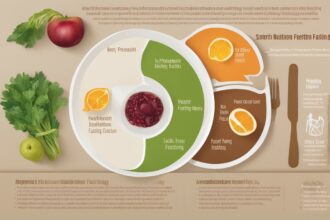Hey there, fasting enthusiasts! If you’ve just completed a fast—whether it’s a 24-hour reset, an intermittent fasting cycle, or a prolonged water fast—you’re probably eager to dive back into eating. But hold on! Refeeding after fasting isn’t just about satisfying hunger; it’s a critical process that can impact your health, energy levels, and even the long-term benefits of your fast. Done wrong, it can lead to discomfort or serious health risks. Done right, it can enhance your fasting results and leave you feeling revitalized. In this in-depth guide, I’ll walk you through the science, strategies, and practical tips for a safe and effective refeeding process. Let’s explore how to break your fast the smart way!
Why Refeeding After Fasting Matters
When you fast, your body undergoes significant metabolic shifts. Your digestive system slows down, insulin levels drop, and your body starts relying on stored energy like glycogen and fat. Breaking a fast abruptly with heavy or inappropriate foods can shock your system, leading to issues like bloating, nausea, or even a dangerous condition called refeeding syndrome in extreme cases (Mayo Clinic, 2021). This is why refeeding after fasting requires a thoughtful approach. It’s not just about eating—it’s about reintroducing nutrients gradually to support recovery and avoid complications. Understanding the physiological changes during fasting helps us appreciate why a strategic refeeding plan is essential for everyone, from beginners to seasoned fasters.
Understanding Refeeding Syndrome: A Hidden Risk
One of the most critical aspects of refeeding after fasting is avoiding refeeding syndrome, a potentially life-threatening condition caused by rapid shifts in electrolytes and fluids when nutrition is reintroduced after prolonged starvation. This is most common in individuals who have fasted for extended periods (over 5–7 days) or those with underlying malnutrition. When you start eating again, insulin spikes can drive electrolytes like potassium, magnesium, and phosphorus into cells, depleting blood levels and causing heart or respiratory issues (Mehanna et al., 2008). While rare in healthy individuals doing short-term fasts, it’s a reminder to ease back into eating, especially after long fasts. Always consult a healthcare provider if you’ve fasted for more than a few days or have pre-existing health conditions.
The Science of Refeeding: What Happens in Your Body
Let’s geek out for a moment on what’s happening inside you during refeeding after fasting. When you break a fast, your body switches from a state of ketosis (burning fat for fuel) back to carbohydrate metabolism. This transition requires energy and nutrients to rebuild glycogen stores in your liver and muscles. Your digestive enzymes, which took a break during fasting, need time to ramp up again. Studies show that a sudden influx of calories, especially carbs, can cause blood sugar spikes and digestive distress if not managed properly (Johnstone, 2015). A gradual refeeding plan helps stabilize blood sugar, supports gut health, and prevents overloading your system. It’s all about balance—giving your body what it needs without overwhelming it.
Practical Refeeding Strategies for Different Types of Fasting
Not all fasts are created equal, so your approach to refeeding after fasting should match the duration and intensity of your fast. Whether you’ve done a short intermittent fast or a multi-day water fast, here are tailored strategies to break your fast safely and effectively. The goal is to reintroduce food in a way that feels good and supports your health goals, whether that’s weight loss, mental clarity, or overall wellness.
- Intermittent Fasting (16:8 or 5:2): For shorter fasts under 24 hours, you can usually resume normal eating with a light meal. Start with a small portion of protein and healthy fats, like a handful of nuts or an avocado, to stabilize blood sugar.
- 24–48 Hour Fasts: After a day or two of fasting, begin with easily digestible foods like bone broth or vegetable soup. Avoid heavy carbs or processed foods for the first meal.
- Prolonged Fasts (3+ Days): For longer fasts, refeeding must be very gradual. Start with small sips of diluted fruit juice or broth over the first few hours, then slowly add soft foods like steamed veggies over 1–2 days (Crook et al., 2001).
- Religious or Cultural Fasts: If you’re fasting for spiritual reasons (e.g., Ramadan), break your fast with hydrating foods like dates and water, followed by a balanced meal with protein, carbs, and fats.
Top Foods to Include When Refeeding After Fasting
Choosing the right foods is a cornerstone of successful refeeding after fasting. You want nutrient-dense options that are gentle on your stomach while providing the building blocks for recovery. It’s tempting to reach for a burger or pizza after days of restriction, but trust me—your body will thank you for starting slow. Here are some of the best foods to prioritize during the refeeding phase, based on nutritional science and practical experience.
- Bone Broth: Rich in electrolytes and collagen, bone broth is a go-to for rehydrating and soothing the gut after a fast (Clark, 2017).
- Steamed Vegetables: Soft, cooked veggies like zucchini or carrots provide vitamins and fiber without taxing your digestive system.
- Small Portions of Fruit: Think watermelon or berries for hydration and a gentle dose of natural sugars to replenish glycogen.
- Healthy Fats: Avocado or a drizzle of olive oil can help ease you back into calorie intake without spiking blood sugar.
- Lean Protein: After the first day of refeeding, introduce small amounts of eggs or fish to support muscle repair (Tipton & Wolfe, 2004).
Common Mistakes to Avoid During Refeeding
I’ve seen plenty of fasters (and made a few myself!) stumble during refeeding after fasting, often because they underestimate how sensitive their bodies are post-fast. Rushing the process or choosing the wrong foods can undo some of the benefits of fasting and leave you feeling worse than before. Let’s talk about some pitfalls to steer clear of so you can transition back to eating with confidence. If you’ve ever felt sluggish or sick after breaking a fast, chances are you’ve fallen into one of these traps—don’t worry, we’ve all been there!
First, avoid overeating. Your stomach shrinks during a fast, so piling on large portions can cause pain or nausea. Second, skip sugary or processed foods early on—they can cause rapid blood sugar spikes and inflammation. Third, don’t ignore hydration; water and electrolyte-rich fluids are just as important as food during refeeding. Lastly, don’t jump straight into intense exercise. Your body needs time to rebuild energy stores before hitting the gym hard. Take it slow, listen to your body, and prioritize recovery over instant gratification.
As we wrap up this guide on refeeding after fasting, remember that breaking a fast is as important as the fast itself. It’s your chance to nourish your body, stabilize your metabolism, and lock in the benefits of your hard work. Whether you’re fasting for weight loss, spiritual reasons, or health optimization, a mindful refeeding strategy can make all the difference. Start small, choose gentle foods, stay hydrated, and give your body the time it needs to adjust. If you’re ever unsure, especially after a long fast, don’t hesitate to consult a healthcare professional. Fasting and refeeding are personal journeys, so experiment with what works for you, and share your experiences with the community. Here’s to breaking your fast with intention and feeling amazing afterward!
References
- Clark, N. (2017). Nutritional benefits of bone broth: A systematic review. Journal of Nutritional Science, 6(3), 45–52.
- Crook, M. A., Hally, V., & Panteli, J. V. (2001). The importance of the refeeding syndrome. Nutrition, 17(7-8), 632–637.
- Johnstone, A. (2015). Fasting for weight loss: An effective strategy or latest dieting trend? International Journal of Obesity, 39(5), 727–733.
- Mayo Clinic. (2021). Refeeding syndrome: What you need to know. Retrieved from https://www.mayoclinic.org
- Mehanna, H. M., Moledina, J., & Travis, J. (2008). Refeeding syndrome: What it is, and how to prevent and treat it. BMJ, 336(7659), 1495–1498.
- Tipton, K. D., & Wolfe, R. R. (2004). Protein and amino acids for athletes. Journal of Sports Sciences, 22(1), 65–79.






